2011.11.09 15:36
Quondam's Fifteenth Anniversary
inconsistantcies and hyperboles?
2000.11.09
Alex,
Thanks for your replies. I now have a better understanding of your evolutionary theory of architectural styles, and for that I'm grateful.
I'll add a few comments, however.
1. I agree that historians will never really know what an artist was thinking, and to that end whenever I analyze historically I try to give exact textual reference and/or make it clear that what I say is my opinion/interpretation (hopefully with some basis). Nonetheless, there is that (exciting) element about historical research that is akin to being a detective finding clues and then 'fabricating' a possible or likely scenario. Moreover, it is more and more the historian's job today to search out and correct the mistakes of previous historians (a kind of Baroque activity?).
2. I'd like to be on the record for proposing that in essence the Baroque involved: a) a bifurcation of reality and illusion, b) pervasive mirroring (figuratively and literally), and 3) reality reenacting its own illusory mirror. For now I'm working on the premise that the combination of these three attributes is mostly unique to the Baroque. [I am not asserting, however, that the artists of the Baroque were actively thinking about the combination of the three attributes when creating their works. I'm simply calling out a (distinct?) pattern that (for me at least) is there.]
3. Please consider my contributions to the recent discussion as addressing the notion of emergence of style as opposed to the invention of a style. [Although, I have to again stress that there really is a lot of invention going on within the designs of Michelangelo's fortifications of Florence.]
4. I'm going to venture into some new activity at architecthetics, and that is to outline and ruminate on the beginnings of Christian Church architecture and specifically the (very possible) role that Flavia Julia Helena Augusta (the mother of Constantine, St. Helena) played within those beginnings. I'll be sporadically sending posts that are more notes than polished texts, and the intention is simply to share the information I've gathered as well as invite comments and questions.
Steve
27 October 312
2000.11.09
On the eve of 27 October 312 Constantine saw a sign (of the Cross?) in the sky that he later attributed as a sign from the Christian God that brought about his 'miraculous' victory over Maxentius the next day at the Milvian bridge just north of Rome.
The 27 October 312 event has come down to us (because Constantine said so under oath) as the moment of his conversion to Christianity. [Please do your own reading/research on the Battle of the Milvian Bridge to get a fuller picture. I'm only calling out this date as the beginning of a Christian imperial regime specifically within the city of Rome, a regime, moreover, very much still existing within the realm of Roman Paganism.]
Constantine was at that time Augustus of the Western half of the empire, and Maxentius was the usurptive ruler of Italy and North Africa. Maxentius was both Constantine's brother-in-law and uncle because Constantine was married to his father's second wife's sister Fausta, the sister of Maxentius and the sister of Theodora, the second wife of Constantius I, the father of Constantine. [By this time Constantine had already caused of death of Maxentius' father, Maximian, who was at his death an ex-Augustus that wanted to be back in power.]
Maxentius died on 28 October 312 at the Battle of the Milvian Bridge which happened to also be the anniversary of Maxentius' own rise to power in Rome on 28 October 306.
Constantine marched triumphantly into Rome on 29 October 312, but he did not end his procession at the (Pagan) Temple of Jupiter on the Arx.
I purposely mention the intricate familial relations of Constantine because there are two matriarchs that survive throughout most of Constantine's reign, namely Helena, the mother of Constantine and first wife of Augustus Constantius I, and Eutropia, the mother-in-law of Constantine and wife of Augustus Maximian. Eutropia is especially interesting because not only is she the grandmother of Constantine's latter five children [the mother of Constantine's first born Crispus was Minervina, not Fausta], but she is also the grandmother of Constantine's five half brothers and sisters. Furthermore, it is interesting that Eutropia survived given the fact that Constantine was the cause of death for both her husband (Maximian) and her son (Maxentius).
[Contrary to all history so far, I speculate that Helena and Eutropia were secretly Christian believers well before 27 October 312, and, moreover, that Christianity was what bonded Helena and Eutropia. I'll return to this towards the end of my posts.]
The first Constantinian Christian basilica in Rome was erected at the Lateran palace, which according to sources originally belonged to Fausta, Constantine's wife. It is thus historically surmised that Fausta was indeed born in Rome when her father Maximian was Western Augustus. In any case, it would seem that the Maximian/Eutropia side of Constantine's family knew Rome very well, while Constantine and Helena themselves were new comers to Rome.
It is not hard to imagine the confusion of emotions that very likely ran through Constanitine's family after the fall of Maxentius. The very question of who was now safe had no definite answer. And it is to the issue of safety first that brings me to my 'theory' of why the Lateran became the first imperially sanctioned Christian site in Rome (as opposed to the site of an apostle's or martyr's burial which is where all subsequent Constantinian basilicas in Rome occurred). It seems reasonable that there were still factions in Rome loyal to Maxentius, let alone against Christianity, and thus the threat to Constantine's family and now also his religious beliefs was indeed extant. As historically recorded, the Lateran palace became the official residence of the then reigning Pope Silvester. The Basilica Constantiniani (which is what St. John Lateran was first called) was built on the grounds of equestrian guards quarters adjacent to the Lateran palace. I speculate that not only did Pope Silvester come to live in the Lateran palace, but that Fausta and her children by Constantine born thus far came to live there as well, plus Eutropia. Thus the imperial family was secure (and removed from the center of Rome) and the Papacy was now officially protected as well, and furthermore, the new Constantinian regime in Rome presented a united Imperial-Christian front to the rest of Rome.
Helena's first residence in Rome may well also have been the Lateran palace, but, if that is the case, she later moved to the Sessorian palace literally down the street from the Lateran, which is today the site of Santa Croce in Gerusalemme.
9 November 312 or 318
2000.11.09
In preparation for my next post regarding the Constantinian Christian basilicas of Rome I planned to collate data from The New Empire of Diocletian and Constantine (Timothy D. Barnes, 1982) which contains an excellent chronological list of "Imperial Residences and Journeys" of all the Augusti and Ceasars from Diocletian to Constantine inclusive with data from Corpus Basilicarum Christianum Romae (Krautheimer), plus refer to a chronology focusing on Helena that I compiled in 1999.
I already found one mistake from my previous post that must be corrected. The first born of Constantine and Fausta, Constantine II, was born 7 August 316, thus there were no children of Constantine other than Crispus alive in 312. Constantine II was born in Arles. (Approximately nine months earlier Constantine was at Trier, 11 January 316 (and before that at Milan 19 October 315). [I'm now asking myself if Constantine's family moved around with him. Was there any move to Rome by family members immediately 28 October 312? I believe there is at least the possibility that Eutropia and even Fausta may have wished to see Rome again after spending the previous four to five years at Trier.]
But here's what really surprised me as I began looking through a set of photocopies from the Corpus Basilicarum Christianum Romae that I made in spring 1999:
[referring the Basilica Constantiniani] Construction need not have taken many years. The huge Basilica Nova [another building] with its time-consuming vaulting system was built and completely decorated in four or five years; and we shall see that at St. Peter's construction and interior decoration were presumably completed in the course of six to eight years. The Lateran basilica, being smaller than St. Peter's, might well have been built and finished within five or six years. dates given for the consecration are numerous, varying from 315 to 324, but they are never based on any sources. The Martyrologium Romanum gives November 9 as the feast day of the basilica, "Romae dedicatio Basilicae Salvatoris". However, as pointed out by Lauer, the date occurs first in the second version of the Descriptio Ecclesiae Lateranensis, 1153-1154: "Cuius dedicatio per totum orbum quinto idus novembris...celebratur...". By that time, then, the tradition was well established, but we do not know how far back it went It is certainly older than the twelfth century, but it does not occur in the early sacramentaries and martyrologia dating from the fifth to ninth century. Is it, then, the date of a reconsecration after the rebuilding by Sergius III (904-911)? This is possible, but it is equally possible that the tradition springs from a fourth century root. We leave the question open. In any event, no year is given. However, it is curious that in the reigns of Constantine and Sylvester, November 9 falls on a Sunday -- since the Middle Ages the customary day for church consecrations -- only four times: 312, 318, 329, 335. The last two dates can be dispensed with: the period of construction [beginning from] 313 or 314 would be too long. However, 318 would be a very plausible date for the consecration of the church. Or should we stress the choice of the word dedicatio, rather than consecratio, by the sources? Dedicatio in Roman legal language is the act of handing over or ceding -- dedere -- an object, be it real estate or something else, to a deity; the act of consecratio follows, once the object has been installed or the shrine, temple or whatever, has been built. Is it possible, then, that November 9, 312, not quite two weeks after his conquest of Rome, was the day Constantine ceded to Christ the terrain on which the basilica was to be built and made the endowment for its future maintenance, in servitio luminum?
It's kind of funny to realize just how much of the above could be absolutely wrong. And at the same time it's also kind of funny that I happened to write about the Lateran basilica on November 9, 2000. To be honest, I've been thinking about writing that opening post regarding the Constantinian Christian basilicas since last Friday (November 3) because that's when my memory was struck by the notion that we just passed the Milvian Bridge battle anniversary, and at that time I was in the shower thinking about Marcus' Halloween post. Marcus' post made me rethink/remember about all the strange coincidences that I encounter throughout 1999 from the very beginnings of my St. Helena research (see 21 May 1999 or 23 September 1999 in the architecthetics archive for prime examples).
This coincidence today actually bothers me because it is just too weird, and it makes me think about a lot of stuff that I wouldn't think of otherwise. Augury can be strange and deceiving. Like Maxentius, who on 28 October 312 entered confidently into battle because it was the anniversary of his rise to power in Rome, you can turn out being completely wrong. Or, like Constantine, you can see the 'sign', act on it, and turn out to be the winner. Personally, I'm not even sure I want to be involved with any of this stuff anymore. It's getting to be just a little too "spooky."
9 November 1778
2000.11.20
Yesterday morning I was looking through the recent Taschen publication of Piranesi's complete etchings, and therein I noticed that Piranesi died on 9 November 1778. With respect to my last post here, I'm now at least pleased that information seems to be 'participating' with my obscure architectural /theoretical researches /entertainments. At the very least I'm now mostly happy that Helena, Eutropia, Constantine and Piranesi still manage to exhibit signs of life. Architectural aesthetics and theories provide such an enormous fertile field, that is seems very true that the best way to enjoy it all is to plant seeds, supply some nurturing, and then watch some tremendous fruit bearing growth emerge.
Piranesi, as far as I can tell, was the most recent past architect/theorist to give architectural homage to Helena. Four plates in the Antichita Romane vol. III depict Helena's (ruined) mausoleum in Rome plus her sepulcher (which is now in the Vatican Museum). In vol. II of the Antichita Romane there are four plates that depict (what is today called) Santa Costanza, (originally the mausoleum of Constantina, the daughter of Constantine, and the grand daughter of Helena and Eutropia), plus Constantina's sepulcher (which is now also in the Vatican museum in the same room as Helena's sepulcher). Piranesi also offers a reconstructed plan of the original Constantinian basilica (it was quite huge) built over the catacomb where St. Agnes was buried, to which Santa Costanza was originally attached.
It was through my research of St. Agnes (on April 1, 1999 - Holy Thursday) in relation to my ongoing research of Piranesi's Ichnographia Campus Martius that I first found out about St. Helena. (I wrote about how all this relates within Piranesi's large plan of the Campo Marzio in a paper I delivered in Brussels a year ago next Saturday.)
Anyway, since what's occupying most of the writers here at architecthetics is what guiding structure there might be for architectural aesthetics today, I suggest looking at various episodes that happened exactly here at architecthetics throughout 1999 -- at the base of a lot of it is the notion of what is trustworthy and what is not trustworthy. Here are some examples, starting with Marcus' post of whether a sculpture can be architecture; my mistrust of Paul's view of Frank Lloyd Wright; Hugh's mistrust of Duchamp's urinal (as faux ready-made); the (dubious?) nature of architectural photography; Alex's mistrust of "hero" historicism.
I like it most when I read people's true feelings versus projection of feelings that are 'supposed' to be had.
I would love to be able to confidently tell you all to trust me when it comes Helena and Piranesi, but I really can't do that without somehow or another seeing things get messy. Nevertheless, I will ask you to trust me when I say that I really enjoy architecture talk, and I therefore really enjoy architecthetics because this is one of the few places (as unreal as it is) that I get to do the talking I enjoy doing.
| |
2011.11.09 09:50
Quondam's Fifteenth Anniversary
Hadrian here beguiled the time in the recollections of his Odysseus-like travels, for this villa built according to his own designs, was the copy and the reflection of the most beautiful things which he had admired in the world. The names of buildings in Athens were given to special parts of the villa. The Lyceum, the Academy, the Prytanetim, the Poecile, even the vale of Tempe with the Peneus flowing through it, and indeed Elysium and Tartarus were all there.
One part was consecrated to the wonders of the Nile, and was called Canopus after the enchanting pleasure grounds of the Alexandrians. Here stood a copy of the famous temple of Serapis, which stood on a canal, and was approached by boat. Hadrian had transplanted Egypt itself to his villa. Sphinxes and statues of gods carved out of black marble and red granite surrounded the god Antinous, who was represented as Osiris in shining white marble. The temples built in Egyptian style were covered with hieroglyphics.
At a sign from the emperor these groves, valleys, and halls would become alive with the mythology of Olympus; processions of priests would make pilgrimages to Canopus, Tartarus and Elysium would become peopled with shades from Homer, swarms of bacchantes might wander through the vale of Tempe, choruses of Euripides might be heard in the Greek theatre, and in a sham fight the fleets would repeat the battle of Xerxes
-Ferdinand Gregorovius, The Emperor Hadrian, A Picture of the Greco-Roman World in his Time (1898).
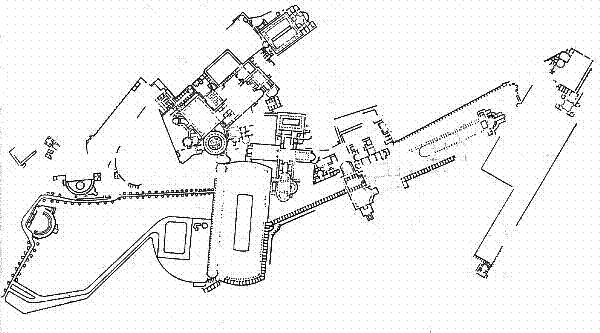
It is exactly the notion of creating an environment to mimic an actual "other" place--the notion of simulacra--that relates Hadrian's villa at Tivoli to today's idea of virtual reality. Far from being a mere imitation or sham, however, the villa is firmly the prototype of "virtual place." Although now largely in ruins, Hadrian's Villa was, in fact, a veritable "museum of virtual places," and, because of the high architectural quality of its many built allusions, it coincidentally functioned as a museum of Roman architecture as well.
Re: Quite a reenactor!!!
2003.09.28 16:55
I see the possibility of Seroux's work being enhanced via HTML in that throughout the text that accompanies each engraved plate there are references from an image or set of images on one engraved plate to other images on another or even several other engraved plates--hyperlinkage could be of benefit here. Moreover, I found that aspects/details of many buildings are distributed throughout the whole set of engravings. For example, a plan of a church may be displayed with other church plans of the same era, but a column from this church is depicted on another engraving that presents a vast variety of columns all arranged in chronological order. The same disbursement goes for details of arches, walls, and domes. In redoing the work utilizing HTML, not only can the work be recreated as originally published albeit with hyperlinks, but whole new 'plates' of drawings can be composed where (for the first time) all aspects of an individual building are displayed together, and these new displays can then be further worked via hyperlinks into the historical outline Seroux already established. I'd also like to add some new text to the Histoire.
Interestingly enough, the drawings (by many top-notch French architectural apprentices that Seroux hired) on which the engravings are based are now at the Vatican Library. And, according to Vidler, the original drawings far surpass the engraved drawings, mostly because the engraved drawings are much reduced from the original size.
My favorite 'discovery' to come out of this exercise so far is learning about the Basilica of St. Stefano, Bologna, thirteenth century, a religious compound where the Court of Pilate and the Church of the Holy Sepulcher, Jerusalem were/are specifically reenacted.
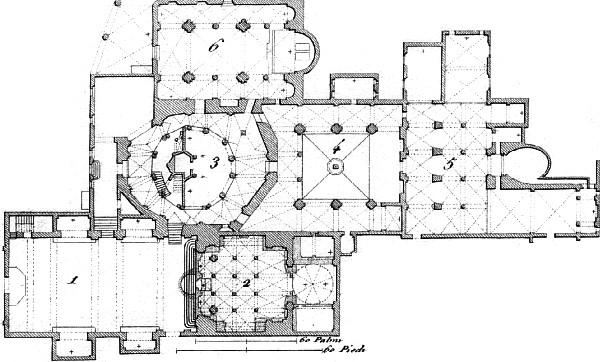
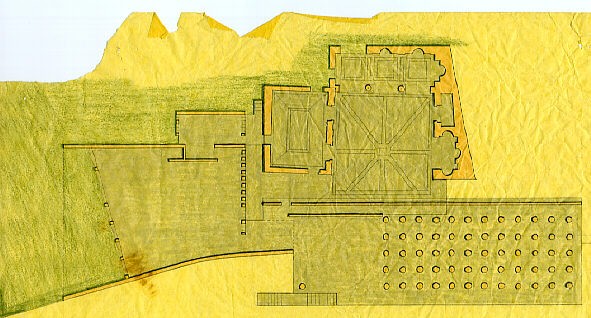
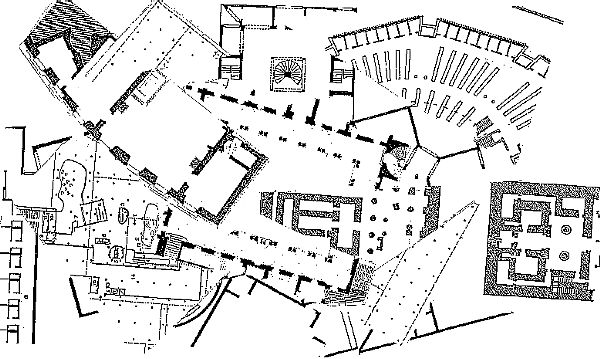
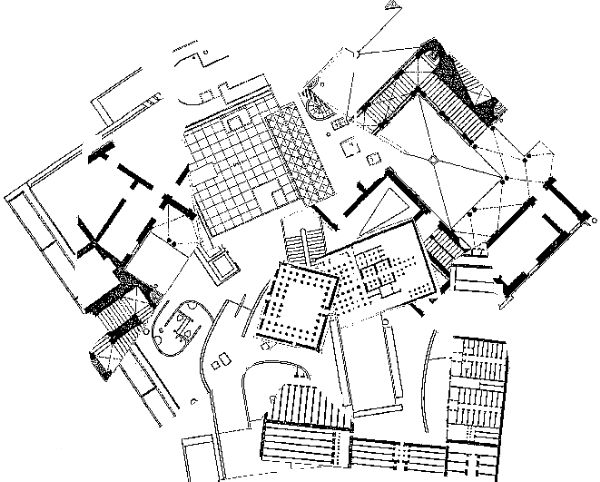
|